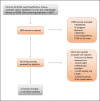Risk factors for infectious complications after retrograde intrarenal surgery - a systematic review and narrative synthesis
- PMID: 34729234
- PMCID: PMC8552946
- DOI: 10.5173/ceju.2021.250
Risk factors for infectious complications after retrograde intrarenal surgery - a systematic review and narrative synthesis
Abstract
Introduction: Infectious complications are among the most frequent and significant complications in retrograde intrarenal lithotripsy. To date, review articles have covered complications after a ureteroscopy, but not after retrograde intrarenal surgery (RIRS), specifically. Because the complications and risk factors are different for a ureteroscopy and RIRS, we aimed to identify variables related to the occurrence of infectious complications post-RIRS.
Material and methods: This systematic review was conducted according to the Preferred Reporting Items for Systematic Reviews and Meta-analyses statement. We included original studies that described 100 or more procedures published in 2014-2021. We extracted data and performed a narrative synthesis to explore and interpret differences between the studies.
Results: We selected 17 studies for analysis, including 10 from 2019-2021. Infectious complications after RIRS were observed in 2.8-7.5% of patients (mean 7.1%). We found seven independent risk factors associated with infectious complications after RIRS: long operative time, recent history of positive urine culture or urinary tract infection or antibiotic use, pyuria/nitrites, small caliber of ureteral access sheath, struvite stone, high irrigation rate, and comorbidities.
Conclusions: If an increased rate of infectious complications is found at a RIRS center, countermeasures should include restrictions on operative time and irrigation rate, and consideration of larger access sheaths, especially for patients with abnormal urine results or with struvite stones or with a history of urinary tract infection or co-morbidities.
Keywords: fever; flexible ureteroscopy; infection; nephrolithiasis; sepsis; systemic inflammatory response syndrome.
Copyright by Polish Urological Association.
Conflict of interest statement
The authors declare no conflicts of interest.
Figures
References
-
- Chugh S, Pietropaolo A, Montanari E, Sarica K, Somani BK. Predictors of Urinary Infections and Urosepsis After Ureteroscopy for Stone Disease: a Systematic Review from EAU Section of Urolithiasis (EULIS) Curr Urol Rep. 2020;21:16. - PubMed
-
- Sun J, Xu J, OuYang J. Risk Factors of Infectious Complications following Ureteroscopy: A Systematic Review and Meta-Analysis. Urol Int. 2020;104:113–124. - PubMed
-
- Page MJ, McKenzie JE, Bossuyt PM, et al. The PRISMA 2020 statement: An updated guideline for reporting systematic reviews. J Clin Epidemiol. 2021;134:178–189. - PubMed
-
- Slim K, Nini E, Forestier D, Kwiatkowski F, Panis Y, Chipponi J. Methodological index for non-randomized studies (minors): development and validation of a new instrument. ANZ J Surg. 2003;73:712–716. - PubMed
Publication types
LinkOut - more resources
Full Text Sources

